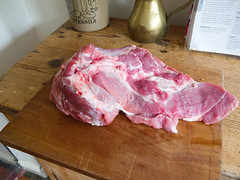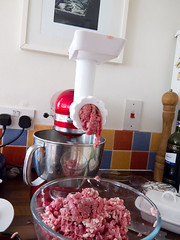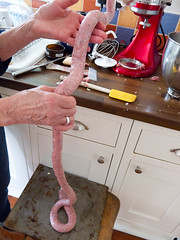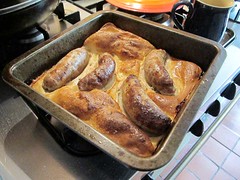How to make your own sausages
Tired of picking bits of gristle out of his bangers, or paying through the nose for posh ones, Nick Harman makes his own. How hard can it be?
What’s in your sausage? The packs promise all kinds of styles and flavours, some more sensible than others. Read the back is more interesting if rather disturbing though. Take the percentage of actual pork included, this can be as low as 32 % in the cheapest sausage (the legal requirement is a minimum of 42% for a ‘pork’ sausage), the remaining 65% being made up of things like bread, rusk and soya as well as an awful lot of salt.
Off the shoulder
So what can you do to be sure of the sanctity of your sausage especially with BBQ season coming up? Make your own of course. I’d been eyeing the unused accessory slot on my Kitchen Aid mixer for ages and decided it’s time to shine had come; it took a few days to get the meat mincer add-on, as well as all the sausage stuffer bits off Amazon but then I was in the banger making business. Many other food mixers can double as mincers and stuffers of course, but you need a tough one.
A question of meat
The big question then of course was what meat to use? Now you can mix pork belly and shoulder for posh sausages but given that it might all end in disaster I decided to hedge my financial bets. Allens of Mayfair, said they’d get me a nice 1.5kg of organic pork shoulder and also source proper intestine casings too. 24 hours later I was in their lovely shop, £8.00 for the lot. And I had enough casing to make hundreds of sausages. Bargain.
A shoulder to rely on
Pork shoulder is perfect for sausages as it has a good ratio of fat in it, a ratio which makes it not so good for roasting and so pretty cheap. To this I planned to add some chopped onion, decent Ile de Re sea salt (not too much), freshly ground black pepper and some egg and water for reasons I’ll explain later.
Mincing
First the mincing. To make it easier always cut the meat into thick strips and stick it in the freezer for about 30 minutes before starting, if you don’t then the already warm fat melts under the pressure of the mincer and the mincer holes clog badly even on a coarse setting. In fact they will clog a bit anyway and it takes some patience to get the job done what with making frequent stops for dismantling, cursing and clearing.
Mixing and prep
Once you have your 1.5kg of mince add 20g of salt, a good teaspoon of pepper, 60g of well-chopped onions, a beaten egg and two teaspoons of water and, if you fancy, some dried herbs and a bit of mace then mix well. Then fit your sausage nozzle, I used the larger size of the two supplied and yelled for the wife to come in to help. Fitting the skins was easy as Allens had supplied professional ones with an inner plastic sleeve. This you place over the greased nozzle and then work the skin off to the back. When you have enough you cut the length and slide away the plastic tube. Then pull off about 3 inches of skin away from the nozzle and tie a good granny knot. Time to start stuffing.
The right stuff
I imagined some Generation Game shenanigans with the sausage skin rapidly filling like a fireman’s hose and becoming uncontrollable, but in fact even with my wife Pauline shovelling mix into the hopper like a stoker on the QE2, nothing much seemed to be happening. This is why you add water and egg, to make the mix a bit slippery and flow better. After a short while though we finally got what might be called the Tortoise’s Head, an emission of sausage mix into the waiting skin, and we were off.
Get into the groove
We soon found a rhythm, one hand needs to control the skin coming off its compressed ring so it doesn’t all try and jump off at once. The other needs to be at the nozzle end, squeezing and shaping in a frankly snigger-inducing way to keep the growing sausage a uniform thickness with no bulges or air gaps. We’d loaded about half a metre of casing on and this first metre was a bit variable in shape to say the least. We tied off the other end and put the long sausage to one side while I reloaded the nozzle.

The second run we got it right, the sausage stayed even all the way along and we tied off. All that was then needed was to twist off the links (alternately clockwise, then anti-clockwise, or they come undone later). We packed them into freezer bags, four to each bag, and left four out for our tea. Good old Toad in the Hole.
How did they taste?
They tasted fantastic; nothing but pure porky flavour in a crisply perfect skin. The meat was moist without being paste, thanks to only using the coarse mincing plate, and the texture juicy and firm. Even with some waste, we’d turned out around 1.5kg of perfect, organic, prime sausages for under a tenner. You can’t argue with that for value and of course knowing exactly what goes in is priceless.
Next time
Next time we intend to divide the mince mix, adding chives to one lot, cooked leeks to another and yes, fresh chilli to a third. Why not? If you’re making sausages, then your sausages can be pure or as imaginative as you like.
Recipes to make with sausages
Comments
Be the first to comment
Do you want to comment on this article? You need to be signed in for this feature




